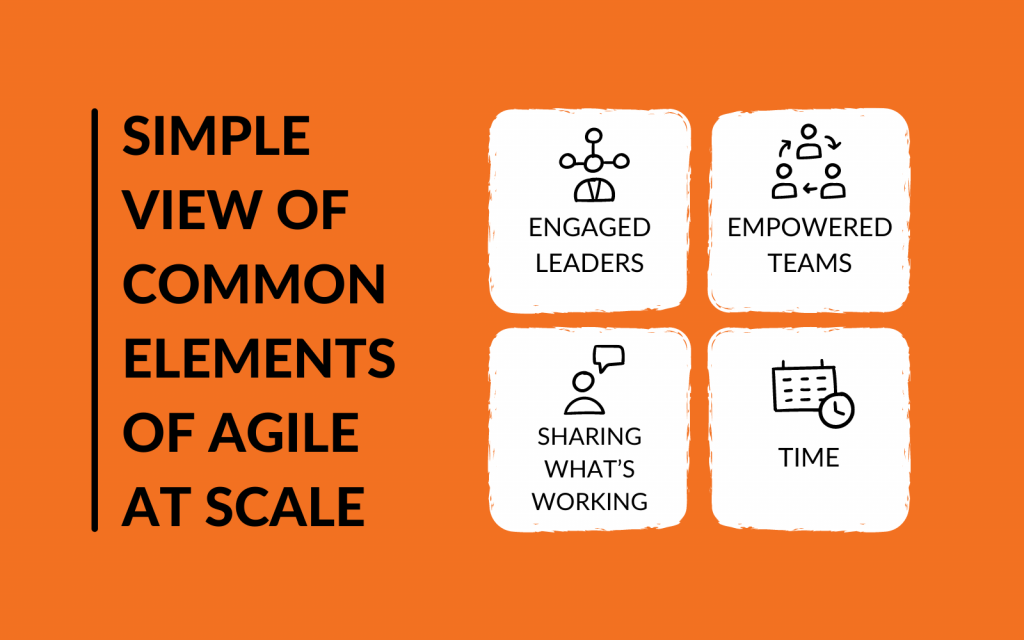
There are some common, simple elements that I’ve observed when agile works at scale across the variety of medium-to-large organisations I’ve had the good fortune of working with.
Making agile work at scale is ultimately about changing behaviour, not just for the individual contributors involved, but also for the leaders. And, changing individual behaviour is hard, so trying to do change at scale is, by definition, even harder.
This difficulty leads us as individuals to complex solutions. “It’s hard, so we must need a complex way to solve it”. It’s what we like to do as humans. I’m guilty of it more often than I’d like.
So, I’ve tried to distil the research, discussions, opinions and practical observations that I’ve come across over the years into a simple view of what makes agile work at scale. The standout elements are:
- Engaged leaders
- Empowered teams
- Sharing what’s working
- Time
These are the elements that have been present when agile has worked at scale. When it doesn’t work, there are a multitude of different specific reasons, but you can usually trace it back to one of these elements not being present.
I’ll unpack each of these elements below and then walk through what I’ve omitted and why.
Common Elements When Agile Works at Scale
1. Engaged Leaders
When agile works, it has engaged leaders. Leaders that understand and model the values and principles from the agile manifesto. Leaders that clear the obstacles and make the organisational changes necessary to empower teams to deliver outcomes.
It’s also just as important for leaders to be explicit about how agile will be adopted, particularly the parts that won’t be adopted or will be challenging. This set(s) expectations with the teams.
2. Empowered Teams
Teams need to be empowered to deliver outcomes. Bringing this back to the Agile Manifesto, it’s usually about allowing teams to work the way they want rather than imposing processes on them. It’s about allowing them to focus on outcomes over powerpoints reporting on output. It’s about allowing teams to adapt to what they think the customer and the business needs over fixing them to a plan.
The teams themselves are also best placed to bring about change, especially the change that is right for them. Most teams know their problems and have ideas on how to solve them. The teams themselves also have the power to change their ways of working, to change their own mindsets, and to influence each other.
3. Sharing What’s Working
Often organisations already have pockets of teams and leaders that are shining lights of better practices (doesn’t even need to be agile-related). But, these teams and their mindset, ways of working and insights often don’t make it beyond their immediate surroundings.
Allowing and supporting teams to share knowledge helps put practices into context and helps demonstrate that “yes, it can be done here, here is an example”.
4. Time
Lastly, the other, often overlooked, element when agile works at scale is time. Change takes time and patience. Time to get the right people in the right roles, time for behaviour to change, time to iterate towards the right working model for your organisation.
I’m guessing it doesn’t show up much in frameworks or models because we can’t control it.
What Wasn’t Common
There are a few ideas that are often put forward as essential to agile working at scale. However, in my observations and research, these weren’t what made agile work. The ideas that aren’t essential to success are:
- No single process, methodology or framework is common to agile working at scale (think SAFe, Scrum or the Spotify Model). In fact, most organisations that I’ve seen running agile at scale use a variety, and some leave it to the teams.
- Agile coaches. There are organisations that have used great coaches to great effect. There are organisations that have made agile work at scale and have done so without coaches, looking instead to their senior leaders and team leaders to mentor their teams.
- Technology and tools. Most teams that made agile work at scale used a variety of tools and technology. You don’t need to be using the latest technology, although it helps. And you don’t need a specific toolset, there are plenty of options.
Closing Thoughts
- Broadly, these elements suggest that approaching agile at scale from the top-down and bottom-up with the patience to allow time for change to occur might be the right framing to come from.
- On reflection, these elements don’t seem unique to agile and could easily be applied to the use of other values systems.
- Agile isn’t the right solution for every organisation and every situation. It’s perfectly okay to adopt the principles and values that work best for your situation. But be honest and clear about this, don’t ignore it.
- I’d love to see some research that simplifies the common elements; if you have any, please send it through. The book Accelerate probably has the closest so far.
The main reason for publishing this was to collect my own thoughts after the discussion generated by my article ‘Agile is Dead, McKinsey Killed It’.

Scott Middleton
CEO & Founder
Scott has been involved in the launch and growth of 61+ products and has published over 120 articles and videos that have been viewed over 120,000 times. Terem’s product development and strategy arm, builds and takes clients tech products to market, while the joint venture arm focuses on building tech spinouts in partnership with market leaders.
Twitter: @scottmiddleton
LinkedIn: linkedin.com/in/scottmiddleton